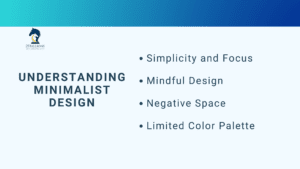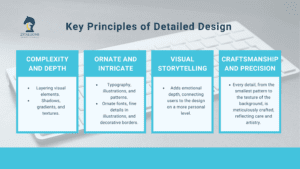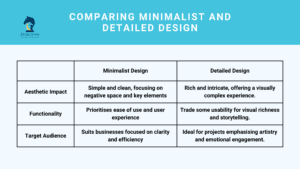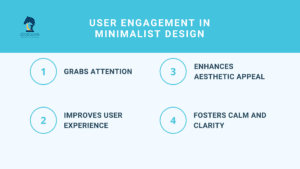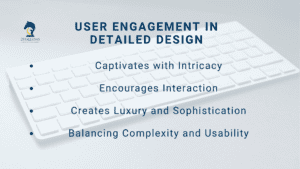Content
SHARE
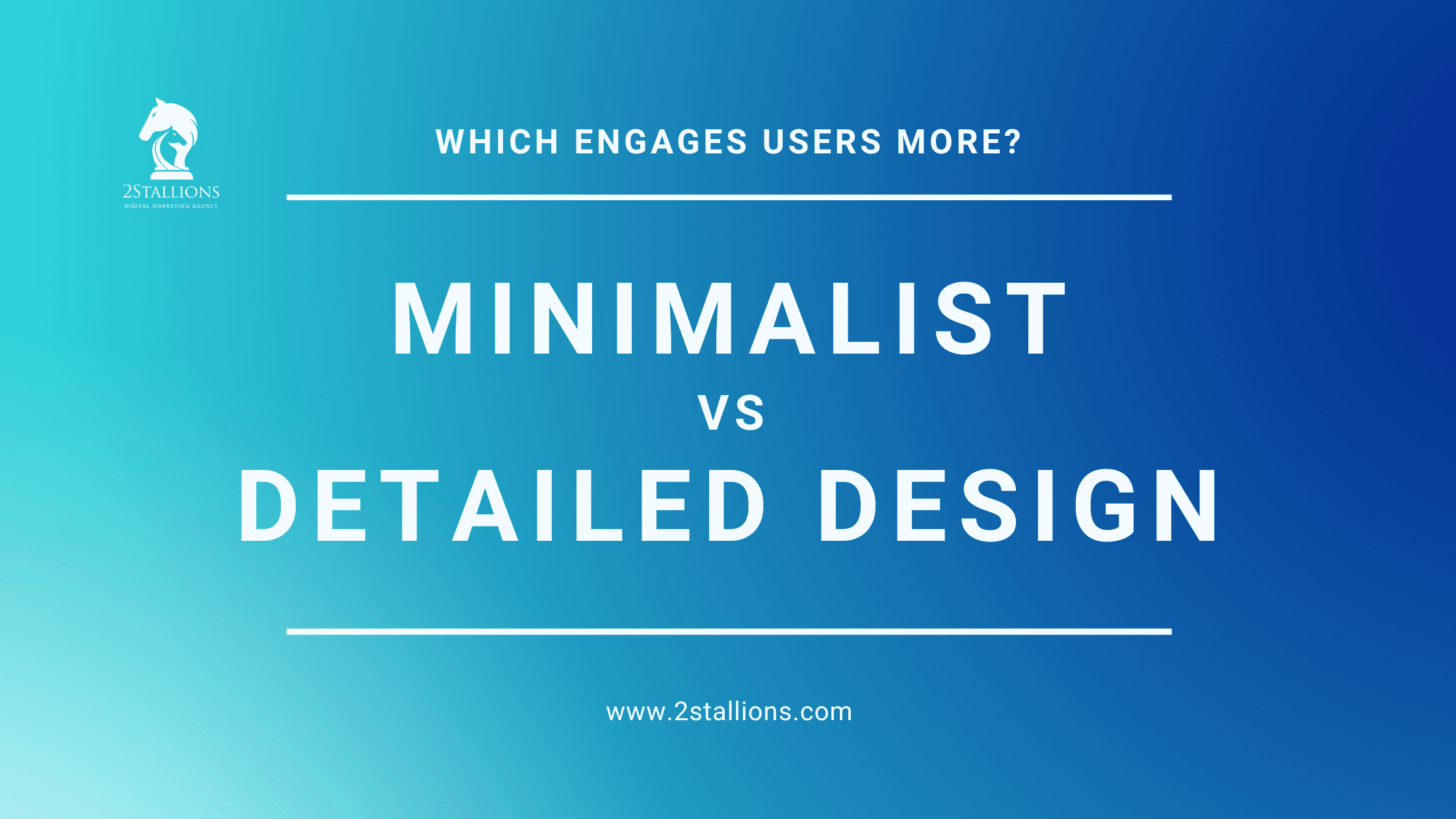
Two contrasting approaches have gained significant popularity in the design world: minimalist and detailed design. Both styles have their merits and draw different reactions from users. The question then arises: which design approach is more engaging for users? Let’s delve deeper into the principles, aesthetics, functionality, and user engagement aspects of minimalist and detailed design.
Understanding Minimalist Design
The philosophy behind minimalist design is to achieve simplicity, harmony, and balance. Eliminating excess elements allows users to focus on a design’s core message or purpose. This approach aims to create a sense of calmness and elegance, promoting clarity and ease of use.
Furthermore, minimalist design is not just about aesthetics; it also reflects a mindset of mindfulness and intentionality. Designers who follow minimalist principles often carefully consider each element’s placement and purpose, ensuring every aspect serves a specific function. This thoughtful approach results in designs that are not only visually appealing but also highly functional.
The Philosophy behind Minimalist Design
A slow-loading website can be a major turnoff for users. It creates a poor user experience, making visitors frustrated and perceive your website as unreliable or outdated. As users expect instant access to information, a slow website can make them feel as if they are wasting precious time waiting for content to appear.
Furthermore, studies have shown that slow-loading websites tend to have higher bounce rates due to users leaving the site without exploring further. This not only affects the immediate user experience but also has long-term consequences for your website’s traffic and engagement metrics.
Imagine this scenario: a potential customer is searching for a product or service that your website offers. They come across your website in the search results and click on the link, excited to find what they need. However, if your website takes ages to load, their excitement quickly turns into frustration. They might even decide to abandon your website and look for alternatives. This not only results in a lost opportunity for conversion but also tarnishes your brand image in the eyes of that potential customer.
On the other hand, a fast-loading website creates a positive user experience. It shows that you value your visitors’ time and have invested in providing them with a seamless browsing experience. This can lead to increased trust, engagement, and ultimately, conversions.
Key Elements of Minimalist Design
Minimalist design typically incorporates negative space, limited colour palettes, and clean typography. It relies on clear lines and simple shapes to convey meaning. By using only essential elements, minimalist design seeks to create a visual language that is minimal yet impactful.
In addition to the visual aspects, minimalist design prioritises usability and user experience. By removing unnecessary clutter and distractions, designers can guide users’ attention to the most important design elements, enhancing usability and overall user satisfaction. This user-centric approach is a key aspect of minimalist design philosophy, ensuring that form follows function most effectively.
Delving into Detailed Design
On the other end of the design spectrum, we have a detailed design. This approach is characterised by intricate elements, rich textures, and visually engaging components. The detailed design aims to captivate users with intricate details, often showcasing craftsmanship and creativity.
When delving into the world of detailed design, one must appreciate the intricacy and dedication level that goes into creating such visually stunning pieces. Each element is carefully crafted to enhance the overall aesthetic and provide a sense of luxury and sophistication.
The Principles of Detailed Design
Detailed design focuses on layering elements, creating depth, and using intricate patterns. It values meticulous arrangement and fine craftsmanship in every design aspect. This approach aims to evoke emotions and create a sense of awe in users.
Furthermore, detailed design often draws inspiration from various sources, including art history, nature, and cultural motifs. By incorporating these diverse influences, designers can create visually compelling pieces that resonate with users on a deeper level.
Components that Make Up Detailed Design
The detailed design incorporates different elements such as ornate typography, intricate illustrations, complex textures, and multi-layered visuals. It is often associated with high levels of detail, complex patterns, and a sense of luxury. This approach strives to create a visually rich and immersive experience for users.
In addition to the visual components, detailed design also emphasises user experience. By carefully considering how users interact with the design, designers can create a seamless and engaging experience that leaves a lasting impression.
Comparing Minimalist and Detailed Design
When comparing minimalist and detailed design, one of the key aspects to consider is the aesthetics and the overall visual impact they create.
Design is a fascinating realm where aesthetic choices can greatly influence the user experience. Minimalist design, fixated on simplicity and clean lines, can evoke a sense of calm and sophistication. The strategic use of negative space with minimalist design creates a feeling of openness and directs the viewer’s focus to key elements, enhancing their significance. In contrast, detailed design captivates with its intricate patterns and ornate embellishments, offering a rich tapestry of visual elements to explore.
Aesthetics: Minimalist vs. Detailed
The simplicity and clean lines characterise the minimalist design. It often uses negative space to create a sense of balance and harmony. On the other hand, detailed design tends to be more ornate and intricate, showcasing a wealth of visual elements. The choice between the two aesthetics depends on the intended message and the desired emotional response from users.
Delving deeper into aesthetics, minimalist design can be likened to a serene Zen garden, where every element serves a purpose and contributes to the overall tranquillity. In contrast, detailed design mirrors the intricate beauty of a Baroque masterpiece, with its elaborate details and opulent decorations drawing the eye in a mesmerising dance of visual splendour.
Functionality: Minimalist vs. Detailed
The minimalist design prioritises functionality and usability. Removing unnecessary elements focuses on enhancing the user experience and making interactions intuitive. Detailed design, while still valuing functionality, may sometimes sacrifice some ease of use in favour of creating a visually immersive experience. The balance between functionality and visual engagement is crucial when considering the target audience and the objectives of the design.
Functionality is pivotal in design, dictating how users interact and navigate a digital space. In minimalist design, “less is more” reigns supreme, focusing on streamlining the user journey and eliminating distractions. On the other end of the spectrum, detailed design embraces complexity, offering users a visual feast that can be captivating and challenging to navigate, akin to exploring a labyrinthine palace filled with hidden treasures.
User Engagement in Minimalist Design
Minimalist design has the unique ability to capture users’ attention through its simplicity and clarity.
When exploring the realm of minimalist design, one must acknowledge the powerful impact it has on user engagement. The deliberate choice to strip away unnecessary elements and focus on the essentials can create a profound visual impact. By embracing white space and clean lines, minimalist design draws the eye to key information, guiding users through a seamless journey of discovery and interaction.
How Minimalist Design Captures Attention
By removing distractions and presenting information concisely and clearly, minimalist design grabs the users’ attention. Its simplicity helps users quickly and easily grasp the intended message, making it particularly effective for conveying important information or calls to action.
Furthermore, minimalist design principles can evoke a sense of elegance and sophistication. The careful curation of elements not only enhances visual appeal but also creates a sense of harmony that resonates with users on a subconscious level. This aesthetic refinement can elevate the overall user experience, leaving a lasting impression on visitors.
The Impact of Minimalist Design on User Experience
Minimalist design often leads to a smooth and effortless user experience. Focusing on essential elements and intuitive navigation helps users navigate the design effortlessly. This simplicity can contribute to a sense of trust and reliability, enhancing the overall user experience.
Moreover, the minimalist approach can foster a sense of calm and clarity in users, allowing them to engage with the content without feeling overwhelmed. By prioritising content hierarchy and readability, minimalist design promotes a sense of ease and accessibility, catering to a wide range of users across different devices and platforms.
User Engagement in Detailed Design
While the minimalist design may excel at clarity and simplicity, the detailed design offers its unique appeal that captivates users.
The Allure of Detailed Design for Users
Detailed design creates a visually immersive experience that can leave a lasting impression on users. Its intricacy and attention to detail invite users to explore and discover elements within the design. This engagement can foster a sense of excitement, wonder, and appreciation for the artistry involved.
The Role of Detailed Design in User Interaction
The detailed design encourages users to interact with the design by exploring its rich textures, intricate patterns, and layered elements. The interactive nature of detailed design can enhance user engagement and create a sense of involvement. However, it is crucial to strike a balance so that the interaction remains intuitive and does not overwhelm or confuse users.
Delving deeper into detailed design, one can appreciate the meticulous craftsmanship and thought that goes into creating such intricate visuals. Designers often spend hours perfecting every detail, from the smallest icon to the overall layout, to ensure a seamless and captivating user experience. This dedication to precision and beauty sets detailed design apart and makes it a compelling choice for those seeking to create a memorable impact.
Furthermore, detailed design elements can evoke a sense of luxury and sophistication, elevating the overall perception of a product or brand. By incorporating intricate details, such as ornate borders, elegant typography, or subtle animations, designers can convey a sense of exclusivity and refinement that resonates with discerning users. This attention to detail enhances the aesthetic appeal of a design and communicates a sense of quality and craftsmanship that can magnify the user’s perception of the brand.
Minimalist and Detailed Designs FAQs
What is the difference between minimalist and detailed design?
Minimalist design focuses on simplicity, clean lines, and essential elements, while detailed design involves rich textures, complex graphics, and intricate visual elements to convey more information and depth.
Which design approach is more effective at engaging users?
The effectiveness depends on the target audience and the context. Minimalist designs are often more engaging for users seeking fast, straightforward interactions, while detailed designs can captivate users looking for immersive and visually rich experiences.
What are the advantages of detailed design for certain audiences?
Detailed design can create an emotional connection by offering a visually engaging and memorable experience. For industries like luxury, entertainment, or gaming, detailed designs often resonate better with users who appreciate aesthetics and storytelling.
What tools can be used to assess and improve website loading speed?
Tools like Google PageSpeed Insights, GTmetrix, and WebPageTest offer comprehensive assessments of a website’s performance, providing specific recommendations for improvements to increase loading speed.

